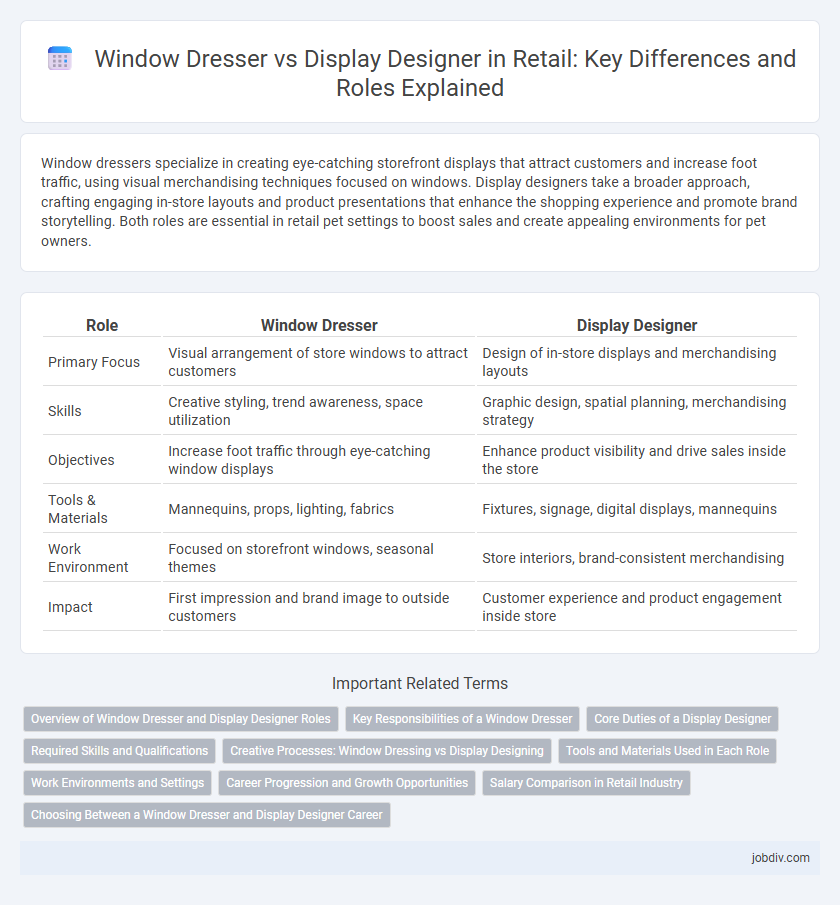Window dressers specialize in creating eye-catching storefront displays that attract customers and increase foot traffic, using visual merchandising techniques focused on windows. Display designers take a broader approach, crafting engaging in-store layouts and product presentations that enhance the shopping experience and promote brand storytelling. Both roles are essential in retail pet settings to boost sales and create appealing environments for pet owners.
Table of Comparison
| Role | Window Dresser | Display Designer |
|---|---|---|
| Primary Focus | Visual arrangement of store windows to attract customers | Design of in-store displays and merchandising layouts |
| Skills | Creative styling, trend awareness, space utilization | Graphic design, spatial planning, merchandising strategy |
| Objectives | Increase foot traffic through eye-catching window displays | Enhance product visibility and drive sales inside the store |
| Tools & Materials | Mannequins, props, lighting, fabrics | Fixtures, signage, digital displays, mannequins |
| Work Environment | Focused on storefront windows, seasonal themes | Store interiors, brand-consistent merchandising |
| Impact | First impression and brand image to outside customers | Customer experience and product engagement inside store |
Overview of Window Dresser and Display Designer Roles
Window dressers specialize in creating visually appealing storefront displays designed to attract and engage potential customers by using props, lighting, and seasonal themes. Display designers focus on crafting in-store layouts and fixtures that enhance the shopping experience through strategic product placement and aesthetic cohesion. Both roles require a keen eye for design, understanding of retail trends, and collaboration with marketing teams to drive sales and brand visibility.
Key Responsibilities of a Window Dresser
Window dressers are responsible for creating visually appealing and thematic window displays that attract customers and enhance store branding. Their key tasks include selecting and arranging merchandise, props, and lighting to highlight products effectively while ensuring alignment with marketing campaigns. They work closely with retail teams to rotate displays regularly, maintaining customer interest and driving foot traffic.
Core Duties of a Display Designer
A Display Designer in retail is responsible for creating visually appealing merchandise presentations that enhance the shopping experience and drive sales. Their core duties include designing and implementing store displays, selecting appropriate props and materials, and collaborating with visual merchandisers and marketing teams to ensure brand consistency. Unlike a Window Dresser who primarily focuses on storefront windows, the Display Designer manages interior layouts and thematic setups across the entire retail space.
Required Skills and Qualifications
Window dressers require proficiency in visual merchandising, creativity, and an eye for detail to create attractive store displays that draw customers. Display designers need advanced skills in graphic design, spatial awareness, and knowledge of materials and lighting to develop innovative and immersive retail environments. Both roles demand strong communication skills and an understanding of consumer behavior to effectively influence shopper engagement.
Creative Processes: Window Dressing vs Display Designing
Window Dressers focus on creating visually appealing storefronts by arranging merchandise, props, and lighting to attract customer attention and convey the brand's seasonal message. Display Designers develop comprehensive in-store displays that integrate layout planning, brand storytelling, and interactive elements to enhance the overall shopping experience and boost customer engagement. Both roles require a strong understanding of color theory, spatial design, and consumer psychology but differ in scale and strategic impact within retail environments.
Tools and Materials Used in Each Role
Window dressers primarily use materials such as mannequins, fabric, lighting fixtures, and props to create visually striking storefront displays that attract passerby attention. Display designers utilize digital tools like CAD software along with structural materials including acrylic, metal, and wood to design and construct in-store displays that combine functionality with brand aesthetics. Both roles require an understanding of color theory and spatial arrangement but differ in the technical complexity and tools tailored to either external window presentations or integrated retail environments.
Work Environments and Settings
Window dressers typically work in retail storefronts, focusing on creating visually appealing window displays that attract customers from outside. Display designers operate in a broader range of settings, including retail stores, trade shows, and museums, designing interior layouts and product presentations to enhance customer engagement. Both roles demand creativity and a strong understanding of visual merchandising, but display designers often collaborate with marketing and product teams in more dynamic environments.
Career Progression and Growth Opportunities
Window dressers typically start with hands-on tasks such as arranging product displays and learn retail visual techniques, offering foundational experience for advancement. Display designers expand their roles by integrating creative concepts with branding strategies, leading to opportunities in visual merchandising management and marketing collaboration. Career progression from window dresser to display designer often involves gaining design software skills and adopting strategic planning responsibilities, enabling growth into senior visual merchandising or creative director positions.
Salary Comparison in Retail Industry
Window dressers in the retail industry typically earn an average salary ranging from $30,000 to $45,000 annually, reflecting their specialized skills in creating visually appealing storefronts. Display designers command higher salaries, often between $45,000 and $65,000 per year, due to their broader responsibilities that include strategic layout planning and enhancing in-store customer experience. Factors influencing these salary differences include experience level, geographic location, and size of the retail company.
Choosing Between a Window Dresser and Display Designer Career
Choosing between a Window Dresser and Display Designer career depends on your passion for visual merchandising and design complexity. Window Dressers excel in creating captivating storefront displays that attract customer attention and boost foot traffic. Display Designers focus on crafting comprehensive interior retail environments, integrating spatial design and brand storytelling to enhance overall customer experience.
Window Dresser vs Display Designer Infographic

 jobdiv.com
jobdiv.com